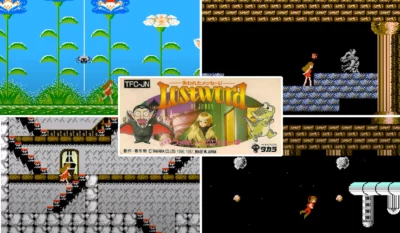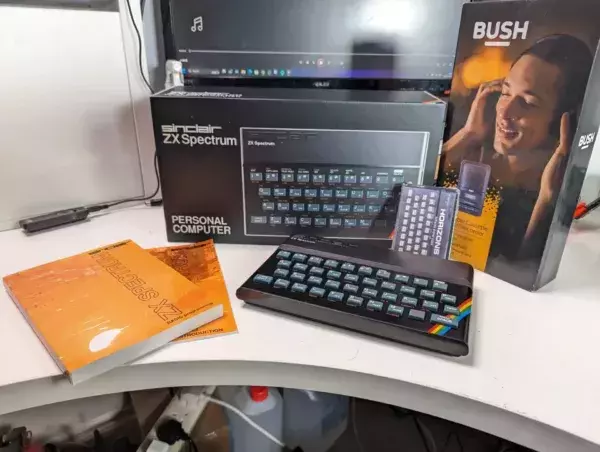
A prominent video game developer once glumly remarked to me that creators don’t get to pick the name of a genre, even if they pioneer it. That axiom probably rings true in other forms as well – hardly any creators willingly heft around the term ‘mumblecore’, for example – but it seems particularly resonant in the world of games, where observers occasionally lament the inherent goofiness of genre descriptors like ‘shmup,’ ‘looter shooter’, and ‘walking simulator’.
Out of the constellation of microgenres that have emerged over the years, however, only one reveals its fundamental obsolescence right there in the name: ‘FMV game’.
Perhaps the most widely derided technological trend to ever sweep the industry, even the term ‘full-motion video’ remains comically out-of-touch, transfixed in amber along with would-be innovators like Betamax and LaserDisc.
Back in the mid-eighties, however, as video games progressed towards ever more elaborate machines that needed shiny software to show off their graphical horsepower, the intersection between the old guard of the film industry and the new industry on the block seemed like an easy bet.
The first attempt arrived with 1983’s Dragon’s Lair, an arcade game that leveraged cinema-quality animation to chomp away your pocket money, 10p (or more) at a time. Sure, the actual game part was entirely less than scintillating – in true quick-time event fashion, press the right button at an arbitrary time or die, often with little-to-no warning – but its sheer detail and charm offered enough novelty to get the gears of industry whirring in its direction.
Ignominious origins
As any devoted scholar of gaming lore knows, the many attempts to capitalise on Lair’s outsized success over the next decade proved mostly fruitless, as they all struggled with the same fundamental problem: nobody knew how to make the interactive part of the ‘interactive movie’ equation any good.
And while there are certainly a handful of beloved games that rely on FMV elements – most notably the Myst series – those that leaned entirely on original footage to differentiate themselves have been rightfully consigned to the dustbin of gaming history, along with failed mascots of the era like Aero the Acro-Bat. (The joke is that he’s an acrobat who’s also a bat. Get it? Why exactly a creature with wings would need acrobatic skill is up to your imagination.)

Featuring animation by Don Bluth, Dragon’s Lair still pops up on modern systems, and recently made an appearance in Netflix nostalgia-fest, Stranger Things.
Of this forgotten crop of early nineties clunkers, only one remains truly notorious: Night Trap. Filmed in the late eighties and released on the doomed Mega CD in 1992, it combined the voyeurism of Hitchcock’s Rear Window with the trite antics of a cheesy slasher movie, with all of the grace that fusion implies.
As a member of the dubious police force SCAT, the player is charged with the task of scrubbing through security footage to protect nubile young women from thugs in trench coats and ski masks who hobble around like they learned to walk from studying diaper commercials. Even in this gentler era, the low-grade thrill of watching crypto-vampires attach a bloodsucking device to Dana Plato’s neck and carry her off into oblivion barely registered to the gaming audience, and the game was largely considered a flop.
Night Trap’s director Rob Fulop calls the project not only a “failed experiment”, but a testament to the limitations of movie/game hybrids – limitations that he feels are native to the form.
“People forget this, but Night Trap was the result of years of planning and development of that technology,” he says. “It might seem funny now, but the idea of playing multiple videos at the same time was considered pretty revolutionary [back then], and possibly had big commercial appeal. But during and after Night Trap, it became apparent to me that you just couldn’t do a lot with the technology…
“When people come to the movies, they want a story, and it just seemed like the game got in the way of the story. There were a couple of interesting things we could do with it, but it wasn’t what we hoped.”
Stoking controversy
As Fulop recalls, he was aghast when pundits outside the industry began to point to his game as an example of the fundamental immorality of the video game medium, along with the infamous Mortal Kombat.
But while Mortal Kombat featured superhuman shinobi who brutally ripped out their opponent’s spine or burned them to a crisp, the implied violence against women depicted in Night Trap – while arguably sexualised to a problematic extent, especially in the glare of 2019 – came at a degree perhaps a hundredth of the films that inspired it, such as Halloween and A Nightmare on Elm Street. But the 1993–1994 congressional hearings that held Night Trap up as a plague infecting the industry didn’t just annoy Fulop – rather, he says they caused him significant personal and professional hardship over the years.

Night Trap was exhibited along with Mortal Kombat as a testament to the overreach of the video games industry in 1993.
“It got to the point that my girlfriend at the time broke up with me,” he says. “She saw the stuff I was making on the TV, and she didn’t know what to think. We were demonised for making a game that looked like a cheesy slasher movie, but it didn’t have any of the blood or gore in it.
“What makes Night Trap worse than those movies? I guess you could say that you can choose not to stop the violence, you can watch them take away Dana Plato, but I don’t think that actually makes it that different. The people running those hearings didn’t understand the game, but we were the ones who had to suffer because of it.”
Yet 25 years later, some indie developers have begun to reassess the humble interactive movie genre, shooting hours and hours of high-definition video and stitching the footage together into new games they shunt onto the crowded shores of Steam. But while the revival remains somewhat nascent – constituting perhaps a few dozen games over the past five years, with only a handful rising to the level of notability – these new efforts are more willing to play with structure and form than their ancient progenitors, resulting in games that strike a far more experimental pose than the likes of Dragon’s Lair.
Take, for instance, The Infectious Madness of Doctor Dekker, which casts you as a psychiatrist trying to solve the murder of one of your colleagues by interrogating his former patients. According to developer Tim Cowles, it was a dream project for him and his wife Lynda, who wrote and developed the game.
From fans to creators
As he recalls, the couple grew close in university through their shared love of the FMV games of the nineties, such as Phantasmagoria. Eventually, after going to a few too many murder mystery nights at pubs and the like, they decided to make their own take on an investigative game, with a supernatural element layered on top. Cowles says that while they were certainly inspired by the classics, it was specifically the success of Sam Barlow’s FMV procedural Her Story that spurred the couple to begin in earnest.
The games they enjoyed back in the day featured a large three-dimensional space with an interface that allowed for a high degree of possible interactions – typical fare for the point-and-click adventures of that era, but expensive and time-consuming to implement as developers on a budget. As Cowles puts it, Barlow’s game proved that you didn’t need a fancy GUI and a sprawling world to make a cinematic game – just one room and a couple of compelling characters.
To help make the game stand out from the incipient crop of competitors, they decided early in the process that rather than including a list of possible questions to ask the suspects, the player would simply type them in, in the style of interactive fiction games. As Cowles puts it, the consequences of this bold design element were even more profound than the couple anticipated.

As we discovered in Wireframe #19, developer Lizi Attwood describes Telling Lies as “an open-world game, except with text.”
“It’s sort of the thing about Dekker,” he says, laughing. “It’s sort of like Marmite, you either love it or hate it. For the console release, we finally relented and put in lists of questions, because it was so controversial. Almost every negative review of Dekker mentions it, that the game didn’t parse their questions correctly. It’s one of those problems that is really hard to solve, and we didn’t realise the extent of it until we were sort of wedded to the decision.
“You can get most of the way to the credits of the game by simply parroting the nouns in the subtitles, because that’s how conversations work, you know? If I’m talking about my pet badger, you’re not going to ask me about my pet parrot. But people complain that it can’t parse ‘age/sex/location’. Have you ever said that to another human being in person? I haven’t. It just doesn’t make sense.”
Cowles understands that his fellow indie developers might view the FMV sub-genre with suspicion, but he says that the format has a number of unique advantages that aren’t apparent at first glance. For one, the footage that was so costly to produce in the heyday of multimedia – Night Trap’s budget was over a million dollars, in unadjusted mid-eighties figures – has become more reasonable thanks to the proliferation of cheap HD cameras. (It’s especially cheap in comparison to the apparent alternative of building a full 3D game, with character models detailed enough to reveal the depth of expression rivalling that of a real human actor, as in L.A. Noire.)
Even so, Cowles says that the form requires a deep skillset, since you’re essentially producing an independent film and a video game simultaneously. “You have to know how to program fairly well, and you need to know how to make a budget run,” he says. “It’s definitely not for everyone.”
A lark turns into a new career
These caveats are echoed by an acquaintance of Cowles, a fellow FMV developer named Tim Follin, who got his start in the games industry as a freelance composer for classics like Blizzard’s Rock N’ Roll Racing. In the mid-nineties, he had the urge to make an investigative game in the style of the British horror movies produced by Hammer Films, where the player would shuffle around the facts of the case like cards on a table and attempt to suss out the contradictions.
However, it wasn’t until 15 years later that he had the technical know-how from working as a director of photography on independent films to actually put the thing together. Titled Contradiction: Spot the Liar!, Follin describes the experience of making the game as a trial by fire, one that revealed just how unprepared he was for the realities of mounting this sort of project as a solo creator.

Rupert Booth’s emphatic performance as Inspector Jenks is widely considered one of Contradiction’s highlights.
“There was no money to pay anyone, really, so I just did everything myself, which was really not healthy,” he says. “All of the actors were friends of the people that I had worked with in the film industry, one of my contacts basically became the de facto casting director.
“Everything that [lead actor] Rupert [Booth] brought to the character of Inspector Jenks, that was all him. People often ask me why the game strikes such a variety of tones, with some actors playing it straight, some hamming it up more. I encouraged them to do it the way they thought it should be done, but we also were running on a very tight budget, so we didn’t have a lot of time for retakes.”
After eleven days of shooting, Follin hoped to craft it into an interactive thriller in less than six months, but it ended up being far more arduous than he expected, and took more than a year. When Contradiction was first released on mobile platforms in early 2015, it didn’t make the jump to Steam until later that summer, shortly after Her Story reintroduced the genre to a new generation of curious players born well after the ‘multimedia’ era.
As Follin puts it, Contradiction ended up being far more successful than he ever imagined, something he chalks up to the game’s campy humour, which makes it play well in Twitch and YouTube streams – he says that an early video by noted gaming site Giant Bomb caused a surge in interest, for example.
While Follin says he’s thankful for the success of Contradiction, he now feels like he’s languishing in the second wave of FMV interest that he helped create. When he sat down to try to make a new project, he realised that he would have to totally overhaul his skillset in order to make a more traditional indie game refined enough to compete with the ever-heightening standards of the market.

Night Trap remains one of the most over-scrutinised games of its era.
So, he stuck with what brought him to the dance, and decided to make another FMV game, this time in the horror genre, titled 3am. But now, a few years into development, he feels frustrated with the whole process of trying to merge the medium of games and film together.
“I think I’ve fallen out of love with FMV games,” he says. “Trying to do something as simple as making the hub area for this game, which is a haunted hotel, has turned out to be so much more difficult than I expected.” Follin says he has extensive reshoots planned in order to get around some of these issues, but says he’s not likely to try to make another game in this style anytime soon.
Not so for Tim and Lynda Cowles – for better or worse, they’re dedicated to the form, having recently announced their third FMV game, a horror-anthology collection of six short episodes. “I’ve never wanted to make any other sort of game,” Tim Cowles says. “It’s just a natural fit for us, and we’ve found our audience.” Yet as one of the fathers of FMV with Night Trap, Fulop takes a more measured view.
He had never heard of Five Nights at Freddy’s, the hit horror franchise that originally relied on a central conceit not unlike that of his twisted child, albeit with the vampires replaced by animatronic horrors. Faced with the lasting legacies of his creation, he was a bit taken aback. “If people want to take the idea and try to go further with it, more power to them,” he says. “But I still think it’s one of those failed experiments. We couldn’t do that much more with it, and it was just too expensive to make. That’s why I stuck to kid-friendly stuff like [successful pet simulator] Petz afterwards.
“Didn’t have to worry about anybody misunderstanding that.”





